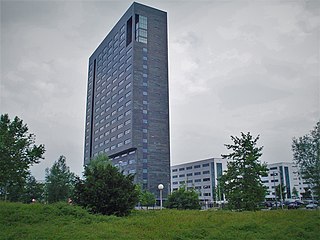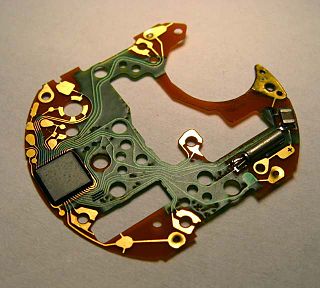Related Research Articles

A field-programmable gate array (FPGA) is a type of integrated circuit that can be programmed or reprogrammed after manufacturing. It consists of an array of programmable logic block and interconnects that can be configured to perform various digital functions. FPGAs are commonly used in applications where flexibility, speed, and parallel processing capabilities are required, such as in telecommunications, automotive, aerospace, and industrial sectors.

MEMS is the technology of microscopic devices incorporating both electronic and moving parts. MEMS are made up of components between 1 and 100 micrometres in size, and MEMS devices generally range in size from 20 micrometres to a millimetre, although components arranged in arrays can be more than 1000 mm2. They usually consist of a central unit that processes data and several components that interact with the surroundings.

A real-time clock (RTC) is an electronic device that measures the passage of time.

Analog Devices, Inc. (ADI), also known simply as Analog, is an American multinational semiconductor company specializing in data conversion, signal processing, and power management technology, headquartered in Wilmington, Massachusetts.

ASML Holding N.V. is a Dutch multinational corporation founded in 1984. ASML specializes in the development and manufacturing of photolithography machines which are used to produce computer chips.
A thin-film bulk acoustic resonator is a device consisting of a piezoelectric material manufactured by thin film methods between two conductive – typically metallic – electrodes and acoustically isolated from the surrounding medium. The operation is based on the piezoelectricity of the piezolayer between the electrodes.
Microchip Technology Incorporated is a publicly listed American corporation that manufactures microcontroller, mixed-signal, analog, and Flash-IP integrated circuits. Its products include microcontrollers, Serial EEPROM devices, Serial SRAM devices, embedded security devices, radio frequency (RF) devices, thermal, power and battery management analog devices, as well as linear, interface and wireless products.

The Pierce oscillator is a type of electronic oscillator particularly well-suited for use in piezoelectric crystal oscillator circuits. Named for its inventor, George W. Pierce (1872–1956), the Pierce oscillator is a derivative of the Colpitts oscillator. Virtually all digital IC clock oscillators are of Pierce type, as the circuit can be implemented using a minimum of components: a single digital inverter, one resistor, two capacitors, and the quartz crystal, which acts as a highly selective filter element. The low manufacturing cost of this circuit and the outstanding frequency stability of the quartz crystal give it an advantage over other designs in many consumer electronics applications.
Micropower describes the use of very small electric generators and prime movers or devices to convert heat or motion to electricity, for use close to the generator. The generator is typically integrated with microelectronic devices and produces "several watts of power or less." These devices offer the promise of a power source for portable electronic devices which is lighter weight and has a longer operating time than batteries.

Quartz clocks and quartz watches are timepieces that use an electronic oscillator regulated by a quartz crystal to keep time. This crystal oscillator creates a signal with very precise frequency, so that quartz clocks and watches are at least an order of magnitude more accurate than mechanical clocks. Generally, some form of digital logic counts the cycles of this signal and provides a numerical time display, usually in units of hours, minutes, and seconds.
GlobalFoundries Inc. (GF) is a multinational semiconductor contract manufacturing and design company incorporated in the Cayman Islands and headquartered in Malta, New York. Created by the divestiture of the manufacturing arm of AMD, the company was privately owned by Mubadala Investment Company, the sovereign wealth fund of the United Arab Emirates, until an initial public offering (IPO) in October 2021.
Tower Semiconductor Ltd. is an Israeli company that manufactures integrated circuits using specialty process technologies, including SiGe, BiCMOS, Silicon Photonics, SOI, mixed-signal and RFCMOS, CMOS image sensors, non-imaging sensors, power management (BCD), and non-volatile memory (NVM) as well as MEMS capabilities. Tower Semiconductor also owns 51% of TPSCo, an enterprise with Nuvoton Technology Corporation Japan (NTCJ).
Microelectromechanical system oscillators are devices that generate highly stable reference frequencies to measure time. The core technologies used in MEMS oscillators have been in development since the mid-1960s, but have only been sufficiently advanced for commercial applications since 2006. MEMS oscillators incorporate MEMS resonators, which are microelectromechanical structures that define stable frequencies. MEMS clock generators are MEMS timing devices with multiple outputs for systems that need more than a single reference frequency. MEMS oscillators are a valid alternative to older, more established quartz crystal oscillators, offering better resilience against vibration and mechanical shock, and reliability with respect to temperature variation.

Integrated Device Technology, Inc., is an subsidiary of Renesas Electronics headquartered in San Jose, California, that designs, manufactures, and markets low-power, high-performance mixed-signal semiconductor products for the advanced communications, computing, and consumer industries. The company markets its products primarily to original equipment manufacturers (OEMs). Founded in 1980, the company began as a provider of complementary metal-oxide semiconductors (CMOS) for the communications business segment and computing business segments. The company focuses on three major areas: communications infrastructure, high-performance computing, and advanced power management.
Achronix Semiconductor Corporation is an American fabless semiconductor company based in Santa Clara, California with an additional R&D facility in Bangalore, India, and an additional sales office in Shenzhen, China. Achronix is a diversified fabless semiconductor company that sells FPGA products, embedded FPGA (eFPGA) products, system-level products and supporting design tools. Achronix was founded in 2004 in Ithaca, New York based on technology licensed from Cornell University. In 2006, Achronix moved its headquarters to Silicon Valley.
Intel Capital is a division of Intel Corporation, set up to manage corporate venture capital, global investment, mergers and acquisitions. Intel Capital makes equity investments in a range of technology startups and companies offering hardware, software, and services targeting artificial intelligence, autonomous technology, data center and cloud, 5G, next-generation compute, semiconductor manufacturing and other technologies.
mCube is a fabless semiconductor company founded in 2009 and headquartered in San Jose, California, and has offices at multiple locations in Hsinchu, Taipei, Shanghai, and Shenzhen. It manufacturesmicroelectromechanical systems (MEMS) motion sensors.

SiTime Corporation is a publicly traded fabless chipmaker based in Santa Clara, California that develops micro-electromechanical systems (MEMS), used for timing devices in electronics.
Pritiraj Mohanty is a physicist and entrepreneur. He is a professor of physics at Boston University. He is most known for his work on quantum coherence, mesoscopic physics, nanomechanical systems, and nanotechnology with a recent focus on biosensing and nanomechanical computing.
References
- 1 2 3 4 R. Colin Johnson (2014-03-09). "Sand 9 MEMS Cracks Cellphone Market". EE Times. Retrieved 2014-06-14.
- ↑ "MEMS Revenue to Climb a Healthy 8 Percent This Year". IHS Technology. June 2, 2013. Retrieved May 14, 2014.
- ↑ Barb Darrow (August 5, 2012). "Top 10 Phat Startups of 2012". Gigaom. Retrieved 2014-06-14.
- 1 2 3 4 5 6 Paul Werbaneth (2013-12-17). "Catching up with Sand 9 at the MEMS Executive Congress 2013". 3D In Cities. Retrieved 2014-06-14.
- ↑ Kyle Alspach (March 9, 2013). "Sand 9 plans Q4 commercial launch, $150M in revenue by 2017". Boston Business Journal. Retrieved 2014-06-14.
- ↑ John Williamson (July 5, 2011). "An Overview of MEMS Based Timing Devices". MEMS Journal. Retrieved 2014-06-14.
- ↑ John Cook (2012-06-19). "Paul Allen and Intel Capital bankroll Sand 9 to reduce dropped calls on cell phones". GeekWire. Retrieved 2014-06-14.
- 1 2 3 Kyle Alspach (2012-11-26). "Sand 9 aims to disrupt $4B timing market in 2013, with better mobile devices a goal". Boston Business Journal. Retrieved 2014-06-14.
- 1 2 3 Steve Taranovich (2013-11-25). "Sand9: The stealth MEMS timing startup". EDN Network. Retrieved 2014-06-14.
- 1 2 3 Tony Massimini (2013-11-20). "Sand9 Rolling Out MEMS Timing Solutions". Semico. Retrieved 2014-06-14.
- ↑ "Sand 9 launches new MEMS timing products". Solid State Technology. Retrieved 2014-06-14.
- ↑ R. Colin Johnson (2013-11-26). "Sand 9 TM651 Is First High-Precision MEMS Oscillator". EE Times. Retrieved 2014-06-14.
- ↑ Graham Pitcher (March 9, 2013). "MEMS developer looks to oust quartz crystals from range of applications". New Electronics. Retrieved 2014-06-14.
- ↑ Erin Kutz (2010-06-24). "Massachusetts Startups Pull in $186M in May; Life Sciences Companies Take the Top Five Deals". Xconomy. Retrieved 2014-06-14.
- ↑ "Intel Capital leads Sand 9 funding round, joins Board". Solid State Technology. 2012-06-19. Retrieved 2014-06-14.
- ↑ "Piezoelectric MEMS Oscillators: Comparison to Quartz Crystals and Capacitive MEMS Solutions". MEMS Journal. May 7, 2012. Retrieved 2014-06-14.